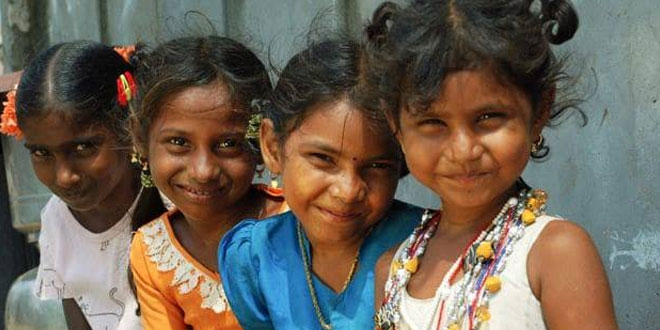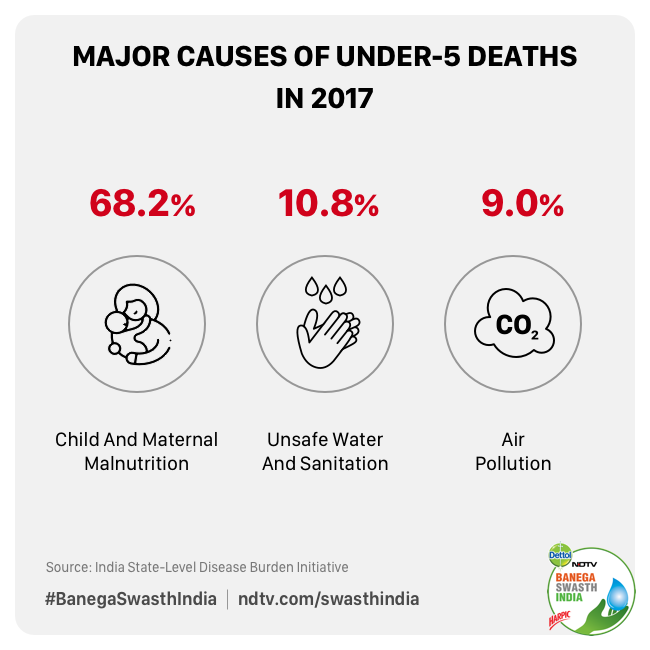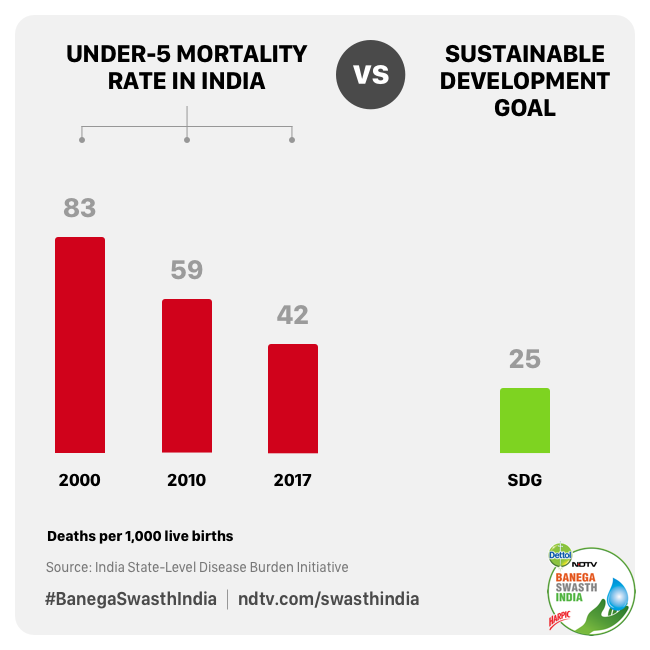Highlights
- Unsafe water caused 11% and air pollution caused 9% of child deaths in 2017
- Under-five mortality is higher in economically underdeveloped districts
- Neonatal Mortality Rate in India has dropped by 38 per cent since 2000
New Delhi: According to two new studies published by ‘India State-Level Disease Burden’ Initiative, the country has made some gains in terms of child survival over the past 20 years. However, the studies also reveal that in order to meet the proposed Sustainable Development Goal (SDG) for child survival by 2030, 34 per cent of total districts in the country would need to do a better job of reducing Under-Five Mortality Rate (U5MR) and 60 per cent of total districts would need to improve the rate of reduction in Neonatal Mortality Rate (NMR), which refers to the number of deaths in first 28 days of life per 1,000 live births.
Also Read: Child, Maternal Malnutrition Led To 68 Per Cent Under-Five Fatalities In India
The ‘India State-Level Disease Burden’ Initiative is a collaboration of Indian Council of Medical Research (ICMR), Public Health Foundation of India (PHFI), Institute for Health Metrics and Evaluation (IHME), and a number of other health agencies in the country, under the aegis of the Ministry of Health and Family Welfare (MoHFW). The two studies – district-level trends of child mortality in India from 2000-2017 and district-level trends of child growth failure have been published in The Lancet and EClinicalMedicine respectively.
India State-Level Disease Burden Study by @ICMRDelhi in collaboration with @thePHFI @IHME_UW shows India's remarkable progress in decreasing Under-5 child mortality since 2000! For more details read the study here: https://t.co/pvRjpAhek8 #WeareICMR @MoHFW_INDIA @drharshvardhan
— ICMR (@ICMRDELHI) May 12, 2020
Professor K Srinath Reddy, President, PHFI said,
Reductions in under-5 child mortality and neonatal mortality are promising as we move towards the SDG targets. Even neonatal mortality which was previously slow to change is now showing improvement. This decline needs to be further accelerated. Child malnutrition is a major factor along with maternal malnutrition for these deaths and should be given highest priority during planning. The inter-state and inter-district gaps in health and nutrition must be quickly bridged through equitable social development, nutrition and environmental health programmes.
Also Read: COVID-19 Could Cause Hundreds Of Thousands Of Additional Child Death: United Nations
Key Risk Factors For Child Survival In India- Malnutrition, Water And Sanitation, Air Pollution
The studies published by ‘India State-Level Disease Burden’ Initiative show that dominant risk factor for under-five death in India in 2017 was child and maternal malnutrition followed by unsafe water, sanitation and air pollution. In the year 2017, child and maternal malnutrition caused 68.2 per cent of under-five deaths and 83 per cent of NMR. 10·8 per cent of under-five deaths could be attributed to unsafe water and sanitation and 9 per cent to air pollution.
According to the study on child growth failure published in EClinicalMedicine titled ‘Mapping of variations in child stunting, wasting and underweight within the states of India: the Global Burden of Disease Study 2000- 2017’, India has shown improvement in tackling child growth failure, measured as stunting, wasting and underweight since 2000.
The World Health Organisation (WHO) defines Stunting as a condition where a child suffers from growth retardation or has low height-for-age; Wasting in children is a symptom of acute undernutrition or has low weight-for-height. According to Dr. Raman Dhara, Additional Professor, Indian Institute of Public Health (IIPH), Hyderabad, while stunting is caused by long-term insufficient nutrient intake and repeated infections, wasting is a result of acute food shortage and illness.
The prevalence of stunting in the country decreased from 55.8 per cent in 2000 to 47.3 per cent in 2010 and 39.3 per cent in 2017. The prevalence of wasting decreased from 19.2 per cent in 2000 to 17.1 per cent in 2010 and to 15.7 per cent in 2017 in the country. The prevalence of underweight decreased from 53.4 per cent in 2000 to 40.9 per cent in 2010, and 32.7 per cent in 2017.
Also Read: Malnutrition – Free India: Lok Sabha Speaker Om Birla Launches ‘Suposhit Maa Abhiyan’ In Kota
Under-Five Mortality Rate In The Country Has Dropped By 49 Per Cent Over The Past 20 Years
The paper on child mortality published in The Lancet titled ‘Subnational Mapping Of Under-5 And Neonatal Mortality Trends In India: The Global Burden Of Disease Study 2000–17’ shows that there were 1.04 million under-five deaths in India in 2017, down from 2.24 million under-five deaths in 2000.
The country has reduced U5MR by 49 per cent over the past 20 years. While in the year 2000, it was 83 deaths per 1,000 live births, U5MR has reduced to 42 deaths per 1,000 live births in 2017. However, it must be noted that it is still far from the SDG target of 25 deaths per 1,000 live births.
The study further reveals that Uttar Pradesh with U5MR of 60 deaths per 1,000 live births and Bihar with U5MR of 44 deaths per 1,000 live births suffered a maximum number of under-five deaths in 2017 (3,12,800 and 1,41,500 respectively). Other poor performing states in 2017 are: Madhya Pradesh, Jharkhand, Rajasthan, Chhattisgarh, Odisha and Assam. The best performing states are: Tamil Nadu, Maharashtra, Sikkim, Kerala, Delhi, Goa.
The annual rate of reduction from 2010 to 2017 for U5MR ranged among the states from 2.7 per cent in Nagaland to 6.5 per cent in Telangana.
According to the study, the U5MR was lower in states with an increasing level of development in the states.
The study shows that across the 723 states across the country that were studied, U5MR varies from 8 to 88 per 1,000 live births and 88 per cent of the districts in the less developed states have U5MR 40 or more per 1,000 live births.
Overall, 34 per cent of the total district would need to improve the rate of reducing the U5MR compared to the 2017 levels in order to meet the SDG 2030 target for U5MR.
Also Read: Nutrition In India: PETA India Calls For Vegan Mid-Day Meals, Experts Differ
A 38 Per Cent Drop In Neonatal Mortality Rate Over The Past 20 Years
When it comes to NMR, the study published in Lancet on child mortality shows that neonatal deaths have nearly halved to 0.57 million neonatal deaths in 2017, down from 1.02 million neonatal deaths in 2000. NMR in the country has reduced by 38 per cent during 2000-2017 from 38 deaths to 23 deaths per 1,000 live births during this period. The study says,
The reduction in NMR has been less than for U5MR, and this reduction has been quite variable across states and districts.
The study shows that across all the districts in the country, the NMR ranged from 6 to 46 deaths per 1,000 live births in 2017. NMR was 20 or more deaths per 1,000 live births in 93 per cent of the districts of low-development states.
It further states that in order to achieve the SDG target of 12 deaths per 1,000 live births, about 60 per cent of all districts of the country need to improve the annual rate of reduction in NMR. The annual rate of reduction of NMR was lower than that of U5MR in all states during 2010-2017 and ranged from 1.8 per cent reduction in NMR in Nagaland to 5.5 per cent reduction in NMR in Tamil Nadu.
Also Read: Malnutrition-Free India: Researchers Develop Tool To Tackle Diet Epidemic In India
[corona_data_new]






























